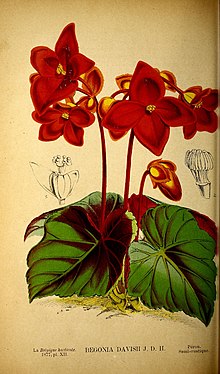| Begonia davisii | |
|---|---|

| |
| Scientific classification | |
| Kingdom: | Plantae |
| Clade: | Tracheophytes |
| Clade: | Angiosperms |
| Clade: | Eudicots |
| Clade: | Rosids |
| Order: | Cucurbitales |
| Family: | Begoniaceae |
| Genus: | Begonia |
| Species: | B. davisii |
| Binomial name | |
| Begonia davisii Hook.f. | |
Begonia davisii is a plant in the begonia family, Begoniaceae, which was used in the early days of breeding Begonia × tuberhybrida cultivars.
It was discovered by the Victorian plant collector Walter Davis (after whom it was named) near Arequipa in Peru and was first introduced to England in 1877.
Description
The plant has a dwarf, tufted habit with broadly ovate–cordate leaves, which are glossy bluish-green above and purplish beneath, with a slightly lobed serrated margin; the flowers are rich orange-scarlet in colour, arranged in threes on erect red-coloured scapes 6 inches (150 mm) to 8 inches (200 mm) high.
Hybridization
The dwarf habit and erect flowers characteristic of this species were taken advantage of by John Seden, who rapidly evolved several garden forms, including a dwarf race of hybrids suitable for summer-bedding which became popular in Victorian England.
The cultivar, B. davisii Orangeade, which has double bright copper–orange flowers, is available commercially today.
References
- John E. Bryan (2002). Bulbs. Timber Press. p. 121. ISBN 0-88192-529-2.
- Geoff Bryant. "Tuberhybrida Cultivars". Country, Farm & Garden. Retrieved 18 November 2008.
- ^ James Herbert Veitch (2006). Hortus Veitchii (reprint ed.). Caradoc Doy. p. 457. ISBN 0-9553515-0-2.
- ^ Hortus Veitchii. p. 232.
- Hortus Veitchii. p. 459.
- "Begonia davisii Orangeade". www.seeds-by-size.co.uk. Retrieved 18 November 2008.
| Taxon identifiers | |
|---|---|
| Begonia davisii | |